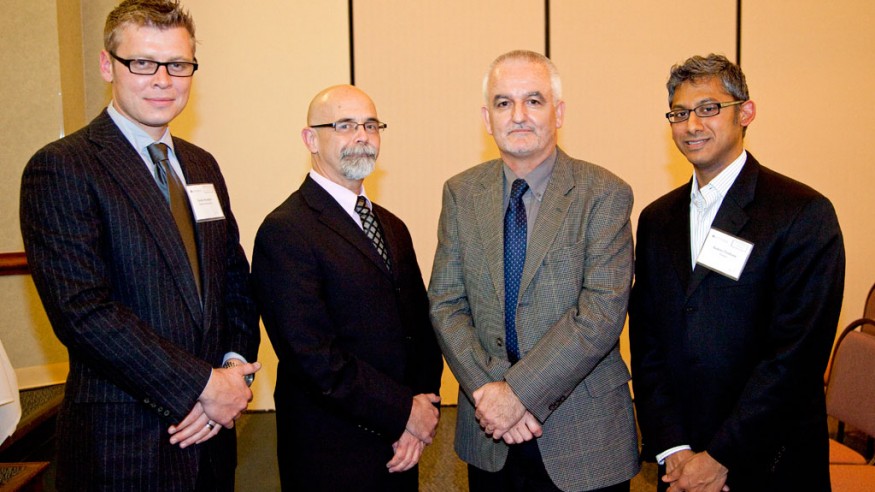
Economists Forecast Slow Growth for 2012
Panelists for the 2011 Economic Outlook conference included (L-R): OWU assistant professor of economics Goran Skosples, moderator; Bill LaFayette, Ian Sheldon, and Guhan Venkatu. (Photo by John Holliger)
Central Ohio is faring better than many parts of the United States since the height of the recession, but the overall picture for the national and global economies is uncertain at best. Such was the assessment of the panel of economists at Ohio Wesleyan University’s annual Economic Outlook Conference on November 7.
Leading the way with a local update was Bill LaFayette, Ph.D., founder of Columbus-based Regionomics LLC, and former vice president of economic analysis for the Columbus Chamber of Commerce. LaFayette noted that the eight-county Columbus metropolitan area had recovered 15,000 of the more than 50,000 jobs lost at the peak of the recession.
Lafayette also reported on several industry sectors that are surpassing national growth trends, including growth in professional and business services, finance and insurance, health care, and retail. However, the region is lagging behind other parts of the country in other sectors, including government jobs, manufacturing, and transportation and warehousing.
Guhan Venkatu, an economist in the Research Department at the Federal Reserve Bank of Cleveland, provided a mixed review of economic indicators for the national forecast. Venkatu pointed to a few positive economic growth trends during the third quarter of 2011, but cited continuing weakness in the labor market as a barrier to a speedier recovery. He projected slight declines in unemployment in the year ahead and said concerns about a “double-dip recession” have ebbed.
Venkatu pointed to “significant downside risks” for the U.S. economy because of increasing strains in global markets. He said the Fed is predicting the current recovery likely will lag behind the pace of previous economic recoveries, predicting up to two years of “frustratingly slow growth.” Venkatu said the central bank’s latest forecast predicts the economy will grow no more than 1.7 percent for all of 2011. For 2012, growth will range between 2.5 percent and 2.9 percent.
Venkatu’s projection set the stage for Ian Sheldon, Ph.D., who focused his analysis for the global economic picture on the ongoing struggles of some members of the European Union and the influence of China’s export policy. Sheldon is the Andersons Professor of International Trade in the Department of Agricultural, Environmental, and Development Economics at The Ohio State University, and he cited the sharp contrast between Germany’s economy and its Euro partners Portugal, Ireland, Greece, and Spain. With Greece teetering on collapse and Spain suffering a liquidity crisis, Sheldon said some experts predict the odds of a Euro Zone collapse could be as high as 35 percent.
The panelists exchanged questions with one another and answered questions from the audience, which packed the Benes Room on Ohio Wesleyan’s Campus. Responding to a question about the difficulty in predicting economic outcomes, Venkatu shared a humorous quote made famous by the late John Kenneth Galbraith: “The only function of economic forecasting is to make astrology look respectable.” Venkatu said that one of the Fed’s rationales for releasing economic forecasts is to generate reaction from various sectors, and to share the Fed’s own perspective as to what forces will shape the nation’s economic landscape in the months ahead.
Ohio Wesleyan’s annual Economic Outlook Conference is co-sponsored by OWU’s Department of Economics and by the Woltemade Center for Economics, Business, and Entrepreneurship. You may watch a video Web stream of the panel discussion at Stream OWU.
